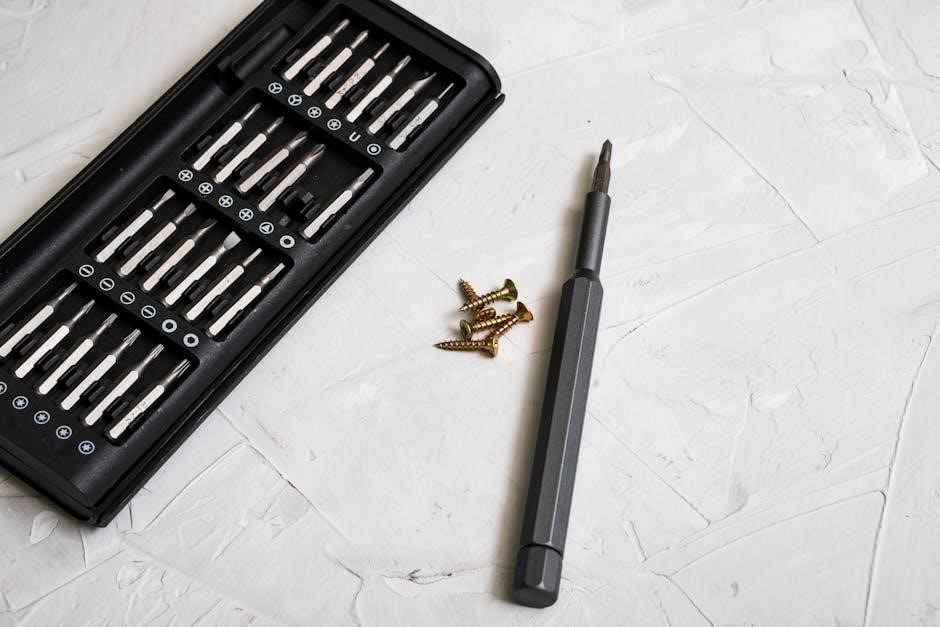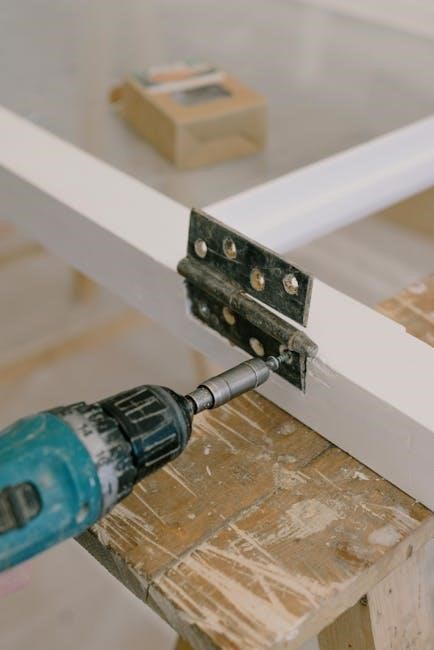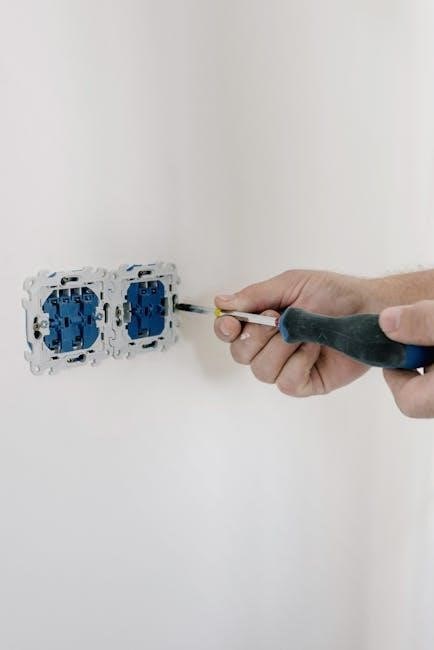Jessem Table Saw Guides are essential for woodworkers seeking precision and safety. They enhance accuracy‚ reduce waste‚ and improve overall woodworking efficiency. Designed for versatility and reliability‚ these guides optimize table saw performance‚ making them a valuable addition to any workshop.
Overview of Jessem Table Saw Guides
Jessem Table Saw Guides are precision-engineered accessories designed to enhance the accuracy and safety of table saw operations. These guides are crafted with durable materials‚ ensuring long-lasting performance and reliability. They are designed to fit seamlessly with various table saw models‚ offering woodworkers a versatile solution for achieving precise cuts. The guides are particularly favored for their ability to minimize material waste and improve workflow efficiency. With their robust construction and user-friendly design‚ Jessem Table Saw Guides are a popular choice among professionals and hobbyists alike. They are also known for their ease of installation and compatibility with a wide range of table saw setups.
Importance of Precision in Table Saw Operations
Precision is critical in table saw operations to ensure accurate cuts‚ enhance project quality‚ and maintain safety. Inaccurate cuts can lead to wasted materials and time-consuming rework. Jessem Table Saw Guides play a key role in achieving this precision by providing consistent and reliable performance. They help woodworkers maintain exacting standards‚ which is especially vital for professional-grade projects. Additionally‚ precision reduces the risk of errors that could result in unsafe operating conditions. By minimizing deviations and ensuring smooth operation‚ these guides contribute to a more efficient and error-free woodworking experience. This level of accuracy is indispensable for both hobbyists and professionals aiming for superior results in their craftsmanship.

Product Overview
Jessem Table Saw Guides offer innovative solutions for precise cutting. Designed for durability and functionality‚ they enhance accuracy and ease of use‚ making them indispensable for woodworkers.
Key Features of Jessem Table Saw Guides
Jessem Table Saw Guides are renowned for their precision and durability. They feature a robust alignment system‚ ensuring accurate cuts every time. The guides are designed with adjustable fences‚ allowing for customizable setups. Constructed from high-quality materials‚ they offer long-lasting performance. Additionally‚ Jessem guides incorporate a quick calibration mechanism‚ saving time and effort. They also include ergonomic handles for ease of use and safety. With their innovative design‚ these guides are compatible with various table saw models‚ making them versatile for different woodworking needs. Their smooth operation and reliability make them a top choice among professionals and hobbyists alike.

Design and Construction Quality
Jessem Table Saw Guides exemplify exceptional design and construction quality. Built with durable‚ high-grade materials‚ they ensure long-term reliability and resistance to wear. The precision-engineered components provide smooth‚ consistent operation‚ minimizing vibrations and noise. Ergonomic design elements enhance user comfort and control‚ while the robust framework supports heavy-duty use. Attention to detail in every part ensures seamless integration with various table saws. The guides’ sturdy construction withstands the demands of professional woodworking environments‚ making them a reliable choice for both hobbyists and professionals. Their superior craftsmanship reflects Jessem’s commitment to delivering tools that meet the highest industry standards for performance and durability.
Compatibility with Various Table Saws
Jessem Table Saw Guides are designed to work seamlessly with a wide range of table saws‚ ensuring universal compatibility. Whether you’re using a professional-grade cabinet saw or a hobbyist-level benchtop model‚ these guides adapt effortlessly. Their versatile design allows for easy installation and adjustment‚ catering to different table saw configurations. This compatibility ensures that users can achieve consistent results without the need for additional modifications or tools. By accommodating various table saw brands and models‚ Jessem Guides provide a reliable solution for woodworkers seeking precision and versatility. Their adaptability makes them an excellent choice for workshops with multiple saws or for those upgrading their equipment. This broad compatibility enhances overall performance and safety across different setups.

Installation and Setup
Installing Jessem Table Saw Guides is straightforward and precise‚ requiring minimal tools and materials. Proper alignment and calibration ensure accuracy‚ while clear instructions guide users for optimal performance.
Step-by-Step Installation Process
The installation of Jessem Table Saw Guides begins with preparing the saw and ensuring a clean‚ dry workspace. First‚ remove any existing guides and thoroughly clean the table. Next‚ align the new guide with the saw’s miter slot‚ ensuring it fits snugly without force. Secure it using the provided hardware‚ tightening evenly to avoid misalignment. Once installed‚ calibrate the guide by making test cuts and adjusting as needed for accuracy. Finally‚ test the setup with various materials to confirm smooth operation. Detailed instructions are typically provided‚ making the process manageable even for less experienced users.
Alignment and Calibration Tips
Aligning and calibrating Jessem Table Saw Guides requires precision to ensure optimal performance. Begin by using a precision straightedge to verify the guide’s alignment with the saw blade. Adjust the guide’s position by loosening the mounting hardware and sliding it into place‚ ensuring it is parallel to the blade. Tighten the hardware securely once aligned. Calibration involves making test cuts and fine-tuning the guide to achieve accurate cuts. Use shims if necessary for minor adjustments. Always refer to the manufacturer’s instructions for specific calibration steps. Proper alignment ensures smooth operation‚ reduces wear‚ and enhances safety. Regular checks and adjustments maintain consistent results over time.
Tools and Materials Required
Installing Jessem Table Saw Guides requires specific tools and materials for accurate setup. Essential tools include an Allen wrench‚ screwdrivers‚ a torque wrench‚ and a carpenter’s square for precise alignment. A set of shims may be needed for fine adjustments. Ensure the table saw is clean and free of debris for proper installation. Additional materials like threadlocker or silicone-based lubricant can enhance stability and longevity. A digital gauge is optional but recommended for precise calibration. Always refer to Jessem’s installation manual for specific requirements. Having all tools and materials ready ensures a smooth and efficient setup process‚ minimizing downtime and ensuring optimal performance of the guides.

Safety Features
Jessem Table Saw Guides prioritize safety with enhanced kickback prevention and emergency stop compatibility. They ensure stable material control‚ reducing accident risks during cutting operations. Built to protect.
Enhanced Safety with Jessem Guides
Jessem Table Saw Guides are designed with safety in mind‚ offering advanced features to minimize risks during operations. Their robust anti-kickback mechanism ensures consistent material control‚ reducing the likelihood of dangerous kickback incidents. Additionally‚ the guides provide stable support for the saw‚ preventing unintended movements that could lead to accidents. The precision engineering of Jessem Guides also helps to maintain even pressure on the workpiece‚ reducing vibrations and noise. These safety enhancements not only protect the user but also extend the lifespan of the table saw. By integrating Jessem Guides into your setup‚ you can work with confidence‚ knowing your safety is prioritized. Their reliability makes them a trusted choice among professionals and hobbyists alike.
Preventative Measures Against Kickback
Kickback is a major safety concern in table saw operations‚ but Jessem Guides offer effective preventative measures. Their design includes anti-kickback features that grip the workpiece firmly‚ reducing the risk of sudden movements. The guides ensure consistent pressure‚ preventing the material from being thrown back. Additionally‚ Jessem Guides promote proper workpiece alignment‚ which is crucial for minimizing kickback. Their stable and rigid construction helps maintain control throughout the cut‚ further enhancing safety. By addressing the root causes of kickback‚ Jessem Guides provide a secure working environment. Regular maintenance of the guides‚ as recommended by the manufacturer‚ ensures their effectiveness in preventing kickback incidents. This proactive approach to safety makes Jessem Guides a reliable choice for woodworkers of all levels.
Emergency Stop Mechanisms
Jessem Table Saw Guides incorporate emergency stop mechanisms to ensure operator safety. These mechanisms are designed to halt operations swiftly in case of an accident or loss of control. The guides often feature easily accessible emergency stop switches or sensors that trigger an immediate shutdown. This rapid response system helps prevent severe injuries and material damage. Additionally‚ Jessem Guides may include failsafe features that engage automatically under certain conditions‚ such as unexpected movement or overload. These mechanisms are seamlessly integrated into the design‚ ensuring they do not interfere with normal operations. By prioritizing safety‚ Jessem Table Saw Guides provide peace of mind and reliable protection for woodworkers. Their emergency stop systems are both intuitive and effective‚ making them a critical component of a safe woodworking environment.

Accessories and Compatibility
Jessem Table Saw Guides offer a range of compatible accessories‚ enhancing functionality and versatility. These include precision alignment tools‚ extension tables‚ and dust collection adapters‚ ensuring seamless integration with various table saw models for improved performance and convenience.
Available Accessories for Jessem Guides
Jessem offers a variety of accessories to complement their table saw guides‚ including precision alignment tools‚ extension tables‚ and dust collection adapters. These accessories enhance functionality‚ ensuring seamless integration with different table saw models and improving overall performance. The alignment tools allow for precise adjustments‚ while extension tables provide additional work surface area. Dust collection adapters help maintain a clean workspace by efficiently managing sawdust and debris. These accessories are designed to optimize the user experience‚ offering convenience and efficiency for both professionals and hobbyists. By expanding the capabilities of the Jessem guides‚ these accessories contribute to a more accurate and productive woodworking process.
Compatibility with Other Table Saw Accessories
Jessem Table Saw Guides are designed to work seamlessly with a wide range of table saw accessories‚ ensuring versatility and convenience. They are compatible with various table saw brands‚ including SawStop‚ Powermatic‚ and Delta‚ making them a universal solution for many workshops. Additionally‚ Jessem guides integrate well with aftermarket fences‚ featherboards‚ and dust collection systems‚ enhancing their functionality. This broad compatibility allows users to maintain their existing setup while upgrading their precision and safety. The guides also work alongside other Jessem products‚ such as their renowned table saw fences‚ creating a cohesive and efficient woodworking system. This adaptability makes Jessem guides a practical choice for woodworkers looking to optimize their tools without compromising on performance.

Maintenance and Care
Regular cleaning and lubrication of Jessem Table Saw Guides ensure smooth operation and longevity. Inspect for wear and tear‚ and store in a dry‚ clean environment to prevent rust.
Cleaning and Lubrication Best Practices
Regular cleaning is crucial for maintaining Jessem Table Saw Guides. Use a soft cloth to wipe down surfaces‚ removing dust and debris. Lubricate moving parts with a high-quality silicone-based spray to ensure smooth operation and prevent corrosion; Avoid using harsh chemicals‚ as they may damage the finish. For stubborn grime‚ mix a mild detergent with water‚ apply with a damp cloth‚ and dry thoroughly. Lubrication should be applied sparingly to avoid attracting dust. After cleaning‚ inspect all components for wear and ensure proper alignment. This routine maintenance will extend the lifespan of your Jessem guides and maintain their precision performance.
Regular Inspection and Replacement of Parts
Regularly inspecting Jessem Table Saw Guides ensures optimal performance and safety. Check for wear on guide rails‚ alignment brackets‚ and adjustment knobs. Look for signs of rust or corrosion on metal components. Replace any worn-out or damaged parts promptly to maintain precision and prevent misalignment. Lubricate moving parts every 50 hours of use to keep them functioning smoothly. Inspect the guide’s mounting hardware for tightness and re-tighten as needed. If any part shows excessive wear‚ refer to the manufacturer’s replacement guidelines. Keeping your Jessem guides in top condition ensures consistent accuracy and extends their lifespan‚ making your woodworking projects easier and more precise.

Troubleshooting Common Issues
Identify and address misalignment‚ vibration‚ or damaged parts promptly. Check guide alignment‚ tighten loose components‚ and replace worn parts to ensure smooth operation and accuracy.
Identifying and Resolving Alignment Problems
Alignment issues with Jessem Table Saw Guides can lead to inaccurate cuts and reduced performance. To identify misalignment‚ inspect the guide’s position relative to the blade and fence. Check for parallelism using a precision measuring tool. If misaligned‚ adjust the guide according to the manufacturer’s instructions‚ ensuring proper calibration. Loose mounting hardware or worn components may also cause alignment problems. Tighten all fasteners and replace any damaged parts. Regular maintenance and precise adjustments are crucial for maintaining optimal accuracy. If issues persist‚ consult the user manual or contact Jessem support for further assistance.
Addressing Vibration and Noise Issues
Vibration and noise issues with Jessem Table Saw Guides can arise from improper installation or wear over time. To address these‚ ensure the guide is securely mounted and aligned with the table saw. Check for loose fasteners and tighten them as needed. Lubricate moving parts to reduce friction and noise. If vibration persists‚ inspect the table saw’s tabletop for unevenness and adjust the guide’s feet accordingly. Regular cleaning and maintenance of the guide’s components can also minimize noise. For severe vibration‚ consider balancing the table saw or consulting Jessem’s support for guidance. Proper setup and maintenance ensure smoother‚ quieter operation.

Comparison with Other Brands
Jessem Table Saw Guides stand out for their precision engineering and durability. They offer superior alignment accuracy and smoother operation compared to many competitors‚ making them a top choice.
Jessem vs. Leading Table Saw Guide Brands
Jessem Table Saw Guides are often compared to other leading brands‚ such as Powermatic and SawStop‚ for their precision and durability. Jessem excels in providing smooth‚ accurate cuts with minimal vibration‚ while Powermatic focuses on heavy-duty construction. SawStop‚ known for its safety features‚ offers advanced technology but at a higher cost. Jessem strikes a balance between affordability and performance‚ making it a preferred choice for many professionals and hobbyists. Its guides are also highly customizable‚ ensuring compatibility with various table saw models. This adaptability‚ combined with their robust design‚ sets Jessem apart in the competitive market of table saw accessories.
Pros and Cons of Jessem Guides
The Jessem Table Saw Guides are highly regarded for their precision and durability‚ offering smooth‚ consistent cuts with minimal vibration. They are easy to install and calibrate‚ making them user-friendly for both professionals and hobbyists. A significant advantage is their compatibility with various table saw models‚ ensuring versatility. However‚ some users find the guides slightly expensive compared to alternatives. Additionally‚ while they are robust‚ regular maintenance is required to maintain optimal performance. Despite these minor drawbacks‚ Jessem Guides are praised for their reliability and ability to enhance woodworking accuracy‚ making them a worthwhile investment for those seeking high-quality results in their projects.

Customer Reviews and Feedback
Customers praise Jessem Table Saw Guides for their exceptional performance‚ durability‚ and ease of use. Many highlight improved accuracy and satisfaction with their woodworking results.
Positive Experiences with Jessem Guides
Many users have shared their positive experiences with Jessem Table Saw Guides‚ highlighting their ease of installation and ability to improve cutting accuracy significantly. Woodworkers appreciate the durable construction and smooth operation‚ which enhances their overall woodworking experience. The guides have been particularly praised for reducing material waste and ensuring consistent results. Several customers mentioned that these guides have become an essential tool in their workshops‚ streamlining their workflows and boosting productivity. The consistent positive feedback underscores the reliability and value of Jessem Table Saw Guides in the woodworking community.
Negative Feedback and Areas for Improvement
While Jessem Table Saw Guides are highly regarded‚ some users have noted a few areas for improvement. A common complaint is the higher price point compared to other brands‚ which can be a barrier for hobbyists or those on a budget. Additionally‚ a few customers have mentioned that the installation process can be somewhat complex‚ requiring precise alignment to ensure optimal performance. There have also been occasional reports of compatibility issues with certain table saw models‚ though this is not widespread. To enhance user satisfaction‚ Jessem could consider offering more detailed installation guides and expanding compatibility options. Addressing these concerns could further solidify their position in the market.
Jessem Table Saw Guides are a top choice for precision and safety‚ offering exceptional performance for professionals and hobbyists alike. Future innovations promise even greater functionality and ease of use.
Final Thoughts on Jessem Table Saw Guides
Jessem Table Saw Guides are a testament to innovation and quality‚ offering unparalleled precision and reliability for woodworkers. Their robust design and ease of use make them a favorite among professionals and hobbyists alike. With a focus on enhancing safety and productivity‚ these guides are an essential tool for any workshop. Users consistently praise their durability and performance‚ making them a worthwhile investment for anyone serious about woodworking. As the woodworking industry evolves‚ Jessem continues to set the standard for excellence in table saw accessories.
Future innovations and customer feedback will likely drive further improvements‚ ensuring Jessem remains at the forefront of woodworking technology.
Future Developments and Innovations
Looking ahead‚ Jessem Table Saw Guides may integrate smart technology‚ such as sensors detecting material types for optimized cuts. Advanced materials could enhance durability and sustainability‚ appealing to eco-conscious users. Future designs might offer seamless integration with other smart workshop tools‚ creating a connected workflow. These innovations would further solidify Jessem’s leadership in woodworking accessories‚ combining precision‚ safety‚ and efficiency for professionals and hobbyists alike.
By staying at the forefront of technological advancements‚ Jessem aims to redefine woodworking standards‚ ensuring their guides remain indispensable for years to come. Continuous feedback from users will likely drive these improvements‚ maintaining Jessem’s reputation for excellence and innovation.






























